Literature Review on Proposal
VerifiedAdded on 2022/08/12
|10
|1546
|13
AI Summary
Contribute Materials
Your contribution can guide someone’s learning journey. Share your
documents today.
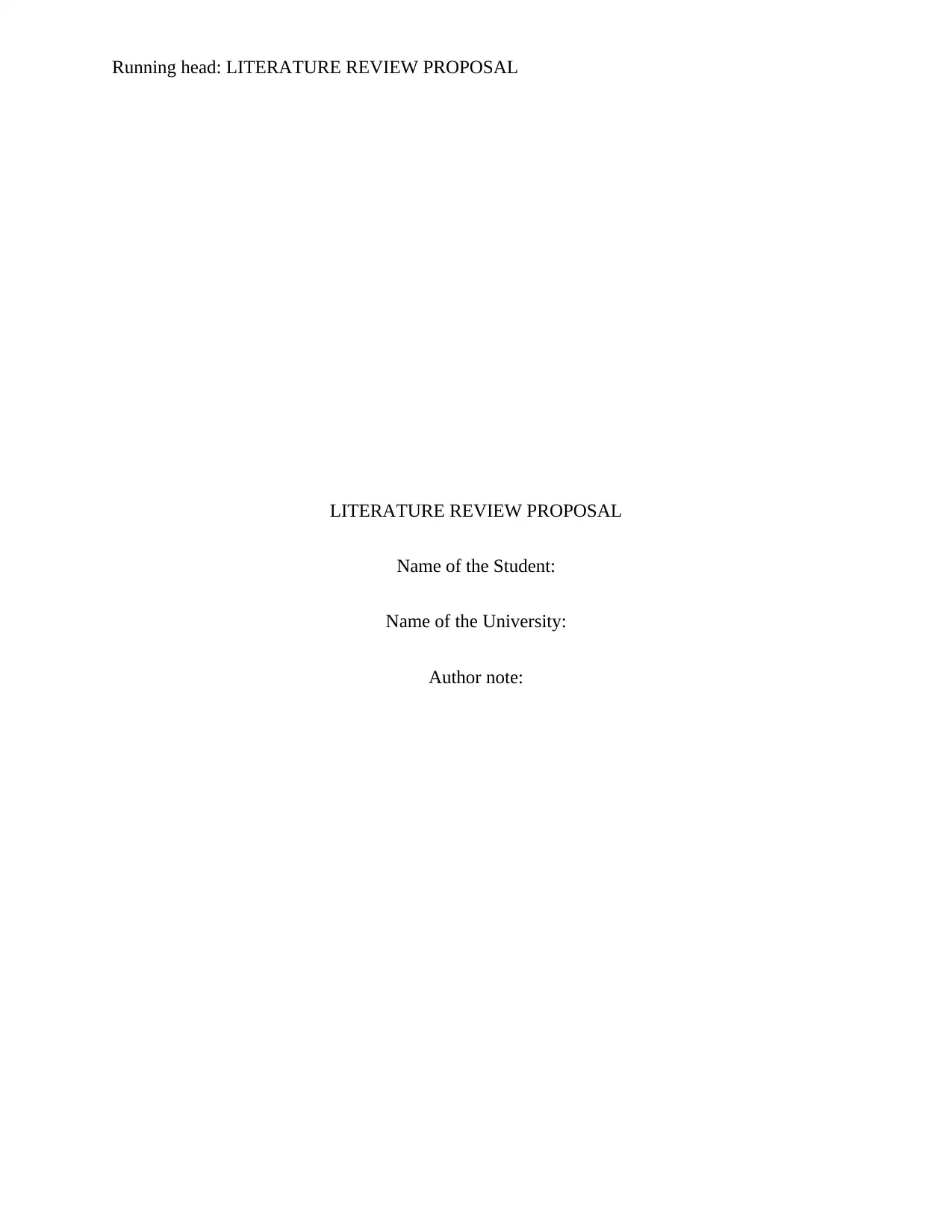
Running head: LITERATURE REVIEW PROPOSAL
LITERATURE REVIEW PROPOSAL
Name of the Student:
Name of the University:
Author note:
LITERATURE REVIEW PROPOSAL
Name of the Student:
Name of the University:
Author note:
Secure Best Marks with AI Grader
Need help grading? Try our AI Grader for instant feedback on your assignments.
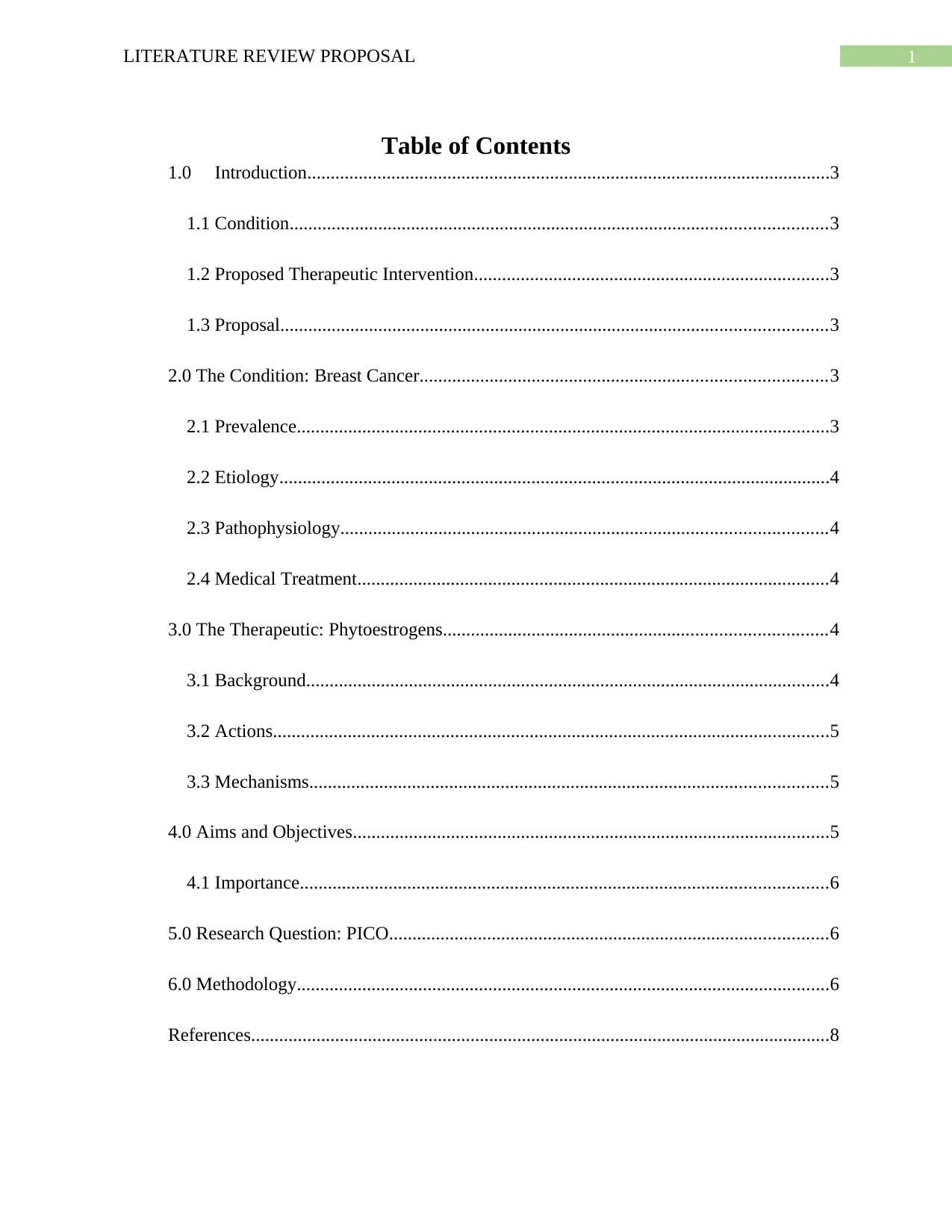
1LITERATURE REVIEW PROPOSAL
Table of Contents
1.0 Introduction................................................................................................................3
1.1 Condition...................................................................................................................3
1.2 Proposed Therapeutic Intervention............................................................................3
1.3 Proposal.....................................................................................................................3
2.0 The Condition: Breast Cancer.......................................................................................3
2.1 Prevalence..................................................................................................................3
2.2 Etiology......................................................................................................................4
2.3 Pathophysiology........................................................................................................4
2.4 Medical Treatment.....................................................................................................4
3.0 The Therapeutic: Phytoestrogens..................................................................................4
3.1 Background................................................................................................................4
3.2 Actions.......................................................................................................................5
3.3 Mechanisms...............................................................................................................5
4.0 Aims and Objectives......................................................................................................5
4.1 Importance.................................................................................................................6
5.0 Research Question: PICO..............................................................................................6
6.0 Methodology..................................................................................................................6
References............................................................................................................................8
Table of Contents
1.0 Introduction................................................................................................................3
1.1 Condition...................................................................................................................3
1.2 Proposed Therapeutic Intervention............................................................................3
1.3 Proposal.....................................................................................................................3
2.0 The Condition: Breast Cancer.......................................................................................3
2.1 Prevalence..................................................................................................................3
2.2 Etiology......................................................................................................................4
2.3 Pathophysiology........................................................................................................4
2.4 Medical Treatment.....................................................................................................4
3.0 The Therapeutic: Phytoestrogens..................................................................................4
3.1 Background................................................................................................................4
3.2 Actions.......................................................................................................................5
3.3 Mechanisms...............................................................................................................5
4.0 Aims and Objectives......................................................................................................5
4.1 Importance.................................................................................................................6
5.0 Research Question: PICO..............................................................................................6
6.0 Methodology..................................................................................................................6
References............................................................................................................................8

2LITERATURE REVIEW PROPOSAL
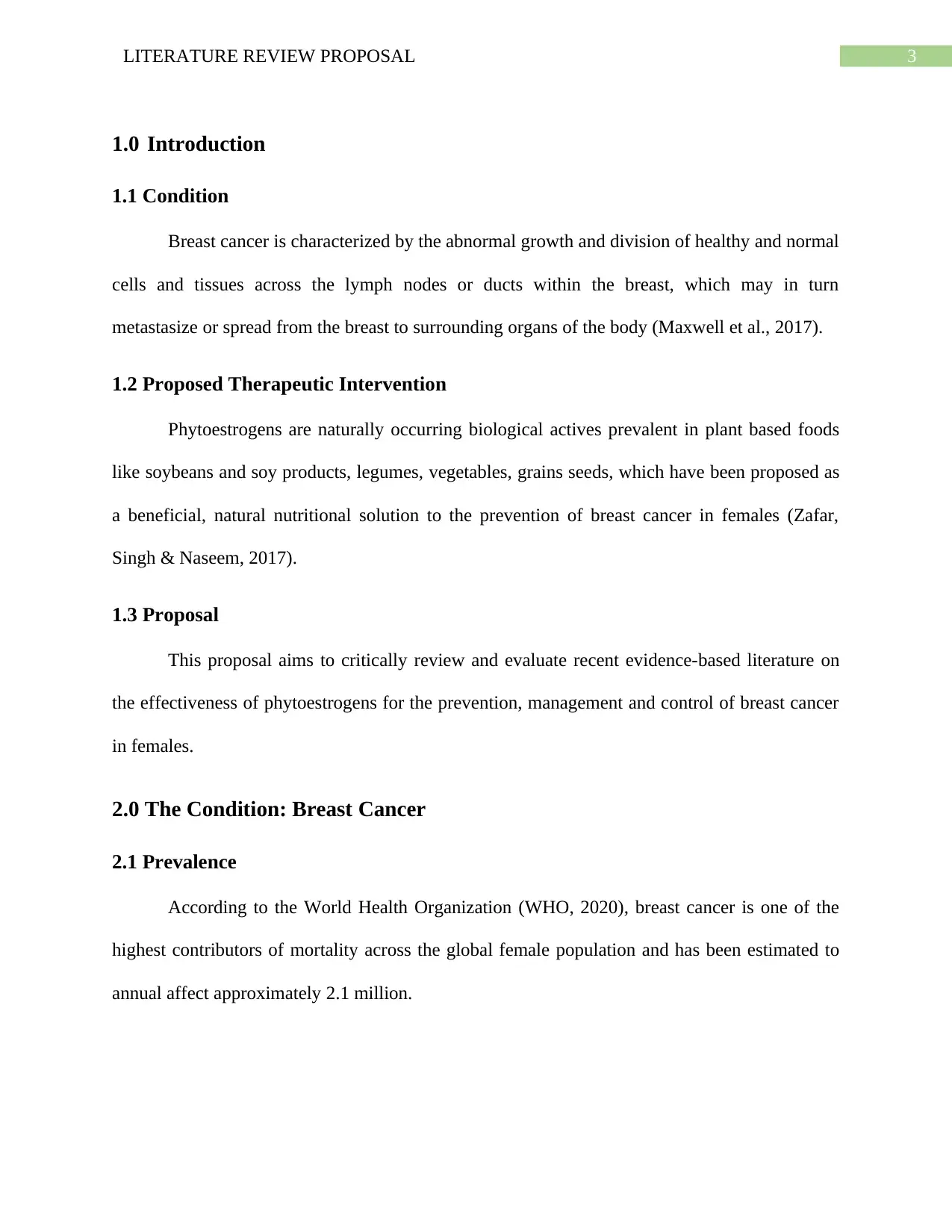
3LITERATURE REVIEW PROPOSAL
1.0 Introduction
1.1 Condition
Breast cancer is characterized by the abnormal growth and division of healthy and normal
cells and tissues across the lymph nodes or ducts within the breast, which may in turn
metastasize or spread from the breast to surrounding organs of the body (Maxwell et al., 2017).
1.2 Proposed Therapeutic Intervention
Phytoestrogens are naturally occurring biological actives prevalent in plant based foods
like soybeans and soy products, legumes, vegetables, grains seeds, which have been proposed as
a beneficial, natural nutritional solution to the prevention of breast cancer in females (Zafar,
Singh & Naseem, 2017).
1.3 Proposal
This proposal aims to critically review and evaluate recent evidence-based literature on
the effectiveness of phytoestrogens for the prevention, management and control of breast cancer
in females.
2.0 The Condition: Breast Cancer
2.1 Prevalence
According to the World Health Organization (WHO, 2020), breast cancer is one of the
highest contributors of mortality across the global female population and has been estimated to
annual affect approximately 2.1 million.
1.0 Introduction
1.1 Condition
Breast cancer is characterized by the abnormal growth and division of healthy and normal
cells and tissues across the lymph nodes or ducts within the breast, which may in turn
metastasize or spread from the breast to surrounding organs of the body (Maxwell et al., 2017).
1.2 Proposed Therapeutic Intervention
Phytoestrogens are naturally occurring biological actives prevalent in plant based foods
like soybeans and soy products, legumes, vegetables, grains seeds, which have been proposed as
a beneficial, natural nutritional solution to the prevention of breast cancer in females (Zafar,
Singh & Naseem, 2017).
1.3 Proposal
This proposal aims to critically review and evaluate recent evidence-based literature on
the effectiveness of phytoestrogens for the prevention, management and control of breast cancer
in females.
2.0 The Condition: Breast Cancer
2.1 Prevalence
According to the World Health Organization (WHO, 2020), breast cancer is one of the
highest contributors of mortality across the global female population and has been estimated to
annual affect approximately 2.1 million.
Secure Best Marks with AI Grader
Need help grading? Try our AI Grader for instant feedback on your assignments.

4LITERATURE REVIEW PROPOSAL
2.2 Etiology
Current evidence indicates the following as the key etiological factors of breast cancer:
increasing age, mutations of genes BRCA2 and BRCA1, family history, high density of breast
tissue, obesity, alcohol intake, exposure to radiation and hormone replace therapy (Pons et al.,
2016).
2.3 Pathophysiology
Mutations in specific genes or damages inflicted upon the DNA of breast cells can initiate
or trigger the uncontrolled and abnormal growth of cells and tissues within the inner ductal lining
of milk ducts or within the lobules responsible for milk supply. These cells and tissues thus
rapidly utilize nutrients from surrounding tissues resulting in further multiplication which is
evident usually in the form of a mass or lump in the breast. If left unmitigated, it can result in
metastasis to other surrounding organs and tissues (López-Biedma et al., 2016).
2.4 Medical Treatment
Common treatments of breast cancer include: breast cancer screening, estrogen inhibitors,
prophylactic mastectomy, prophylactic oophorectomy, and lumpectomy and node dissection
(López-Biedma et al., 2016).
3.0 The Therapeutic: Phytoestrogens
3.1 Background
Phytoestrogens are natural occurring compounds in plant foods with a chemical structure
similar to estrogen and which instill estrogen-like functions with weakened potency. These
include: coumestans (legumes, sprouts, and alfalfa), isoflavones (chickpea, soy, legumes) and
lignans (vegetables, grains and linseed) (Hsieh et al., 2018).
2.2 Etiology
Current evidence indicates the following as the key etiological factors of breast cancer:
increasing age, mutations of genes BRCA2 and BRCA1, family history, high density of breast
tissue, obesity, alcohol intake, exposure to radiation and hormone replace therapy (Pons et al.,
2016).
2.3 Pathophysiology
Mutations in specific genes or damages inflicted upon the DNA of breast cells can initiate
or trigger the uncontrolled and abnormal growth of cells and tissues within the inner ductal lining
of milk ducts or within the lobules responsible for milk supply. These cells and tissues thus
rapidly utilize nutrients from surrounding tissues resulting in further multiplication which is
evident usually in the form of a mass or lump in the breast. If left unmitigated, it can result in
metastasis to other surrounding organs and tissues (López-Biedma et al., 2016).
2.4 Medical Treatment
Common treatments of breast cancer include: breast cancer screening, estrogen inhibitors,
prophylactic mastectomy, prophylactic oophorectomy, and lumpectomy and node dissection
(López-Biedma et al., 2016).
3.0 The Therapeutic: Phytoestrogens
3.1 Background
Phytoestrogens are natural occurring compounds in plant foods with a chemical structure
similar to estrogen and which instill estrogen-like functions with weakened potency. These
include: coumestans (legumes, sprouts, and alfalfa), isoflavones (chickpea, soy, legumes) and
lignans (vegetables, grains and linseed) (Hsieh et al., 2018).
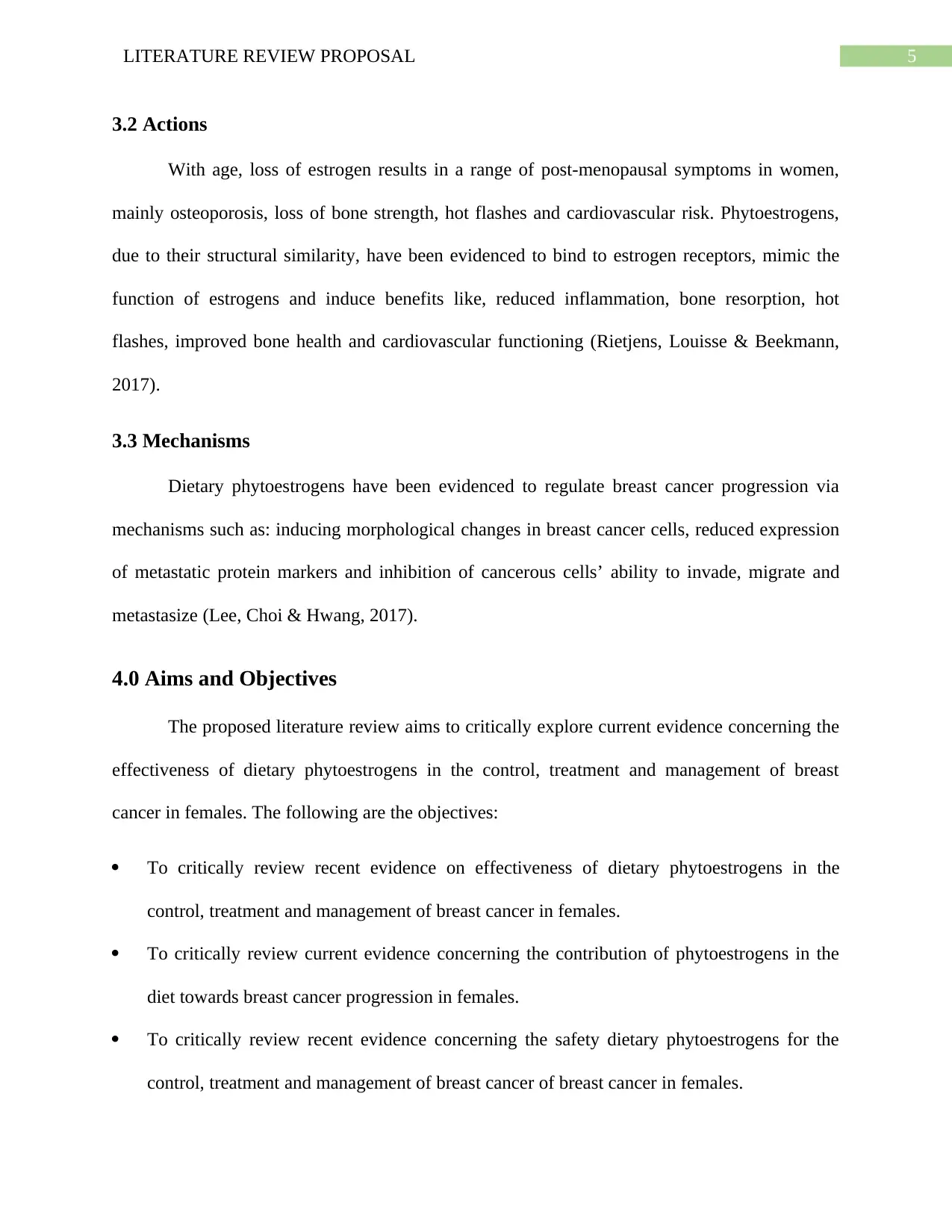
5LITERATURE REVIEW PROPOSAL
3.2 Actions
With age, loss of estrogen results in a range of post-menopausal symptoms in women,
mainly osteoporosis, loss of bone strength, hot flashes and cardiovascular risk. Phytoestrogens,
due to their structural similarity, have been evidenced to bind to estrogen receptors, mimic the
function of estrogens and induce benefits like, reduced inflammation, bone resorption, hot
flashes, improved bone health and cardiovascular functioning (Rietjens, Louisse & Beekmann,
2017).
3.3 Mechanisms
Dietary phytoestrogens have been evidenced to regulate breast cancer progression via
mechanisms such as: inducing morphological changes in breast cancer cells, reduced expression
of metastatic protein markers and inhibition of cancerous cells’ ability to invade, migrate and
metastasize (Lee, Choi & Hwang, 2017).
4.0 Aims and Objectives
The proposed literature review aims to critically explore current evidence concerning the
effectiveness of dietary phytoestrogens in the control, treatment and management of breast
cancer in females. The following are the objectives:
To critically review recent evidence on effectiveness of dietary phytoestrogens in the
control, treatment and management of breast cancer in females.
To critically review current evidence concerning the contribution of phytoestrogens in the
diet towards breast cancer progression in females.
To critically review recent evidence concerning the safety dietary phytoestrogens for the
control, treatment and management of breast cancer of breast cancer in females.
3.2 Actions
With age, loss of estrogen results in a range of post-menopausal symptoms in women,
mainly osteoporosis, loss of bone strength, hot flashes and cardiovascular risk. Phytoestrogens,
due to their structural similarity, have been evidenced to bind to estrogen receptors, mimic the
function of estrogens and induce benefits like, reduced inflammation, bone resorption, hot
flashes, improved bone health and cardiovascular functioning (Rietjens, Louisse & Beekmann,
2017).
3.3 Mechanisms
Dietary phytoestrogens have been evidenced to regulate breast cancer progression via
mechanisms such as: inducing morphological changes in breast cancer cells, reduced expression
of metastatic protein markers and inhibition of cancerous cells’ ability to invade, migrate and
metastasize (Lee, Choi & Hwang, 2017).
4.0 Aims and Objectives
The proposed literature review aims to critically explore current evidence concerning the
effectiveness of dietary phytoestrogens in the control, treatment and management of breast
cancer in females. The following are the objectives:
To critically review recent evidence on effectiveness of dietary phytoestrogens in the
control, treatment and management of breast cancer in females.
To critically review current evidence concerning the contribution of phytoestrogens in the
diet towards breast cancer progression in females.
To critically review recent evidence concerning the safety dietary phytoestrogens for the
control, treatment and management of breast cancer of breast cancer in females.
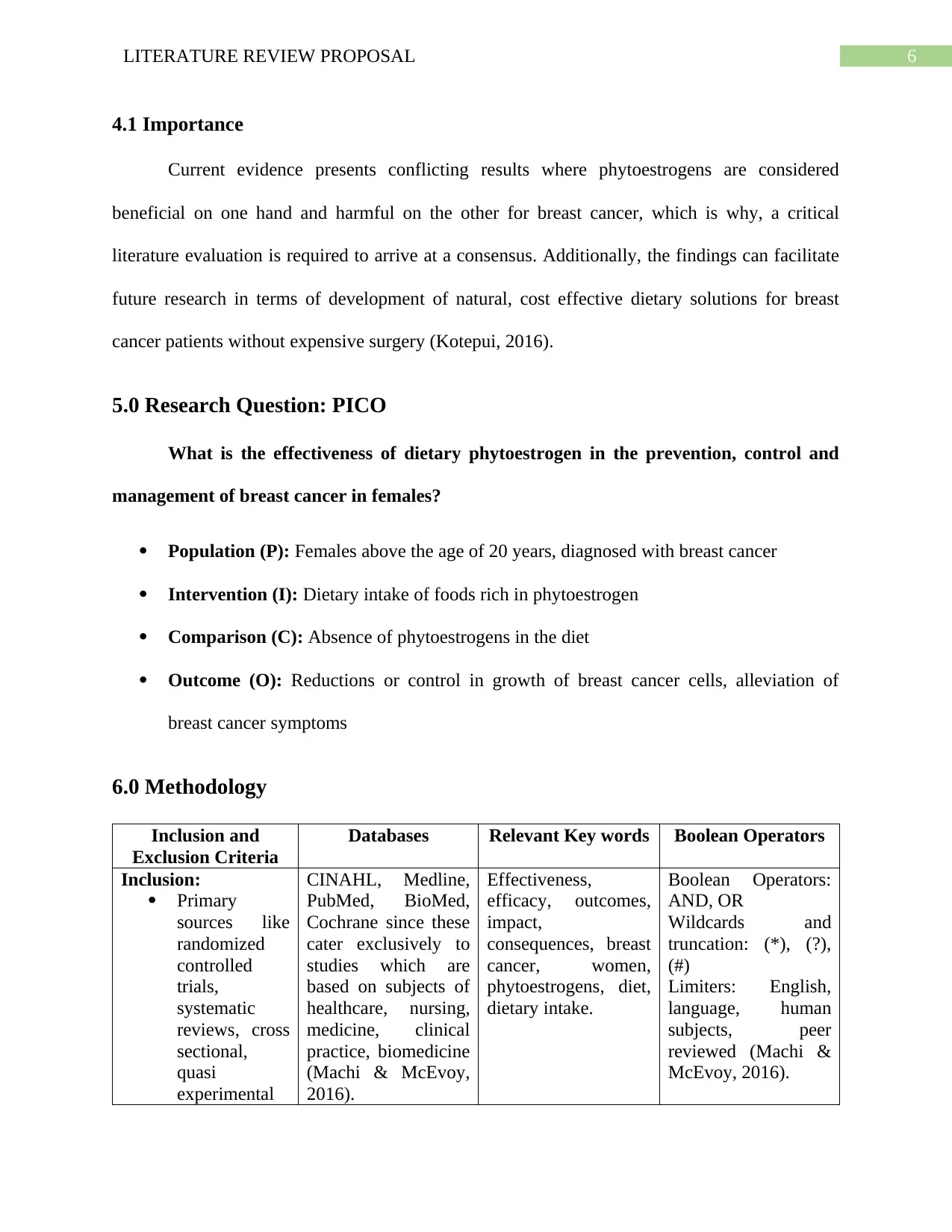
6LITERATURE REVIEW PROPOSAL
4.1 Importance
Current evidence presents conflicting results where phytoestrogens are considered
beneficial on one hand and harmful on the other for breast cancer, which is why, a critical
literature evaluation is required to arrive at a consensus. Additionally, the findings can facilitate
future research in terms of development of natural, cost effective dietary solutions for breast
cancer patients without expensive surgery (Kotepui, 2016).
5.0 Research Question: PICO
What is the effectiveness of dietary phytoestrogen in the prevention, control and
management of breast cancer in females?
Population (P): Females above the age of 20 years, diagnosed with breast cancer
Intervention (I): Dietary intake of foods rich in phytoestrogen
Comparison (C): Absence of phytoestrogens in the diet
Outcome (O): Reductions or control in growth of breast cancer cells, alleviation of
breast cancer symptoms
6.0 Methodology
Inclusion and
Exclusion Criteria
Databases Relevant Key words Boolean Operators
Inclusion:
Primary
sources like
randomized
controlled
trials,
systematic
reviews, cross
sectional,
quasi
experimental
CINAHL, Medline,
PubMed, BioMed,
Cochrane since these
cater exclusively to
studies which are
based on subjects of
healthcare, nursing,
medicine, clinical
practice, biomedicine
(Machi & McEvoy,
2016).
Effectiveness,
efficacy, outcomes,
impact,
consequences, breast
cancer, women,
phytoestrogens, diet,
dietary intake.
Boolean Operators:
AND, OR
Wildcards and
truncation: (*), (?),
(#)
Limiters: English,
language, human
subjects, peer
reviewed (Machi &
McEvoy, 2016).
4.1 Importance
Current evidence presents conflicting results where phytoestrogens are considered
beneficial on one hand and harmful on the other for breast cancer, which is why, a critical
literature evaluation is required to arrive at a consensus. Additionally, the findings can facilitate
future research in terms of development of natural, cost effective dietary solutions for breast
cancer patients without expensive surgery (Kotepui, 2016).
5.0 Research Question: PICO
What is the effectiveness of dietary phytoestrogen in the prevention, control and
management of breast cancer in females?
Population (P): Females above the age of 20 years, diagnosed with breast cancer
Intervention (I): Dietary intake of foods rich in phytoestrogen
Comparison (C): Absence of phytoestrogens in the diet
Outcome (O): Reductions or control in growth of breast cancer cells, alleviation of
breast cancer symptoms
6.0 Methodology
Inclusion and
Exclusion Criteria
Databases Relevant Key words Boolean Operators
Inclusion:
Primary
sources like
randomized
controlled
trials,
systematic
reviews, cross
sectional,
quasi
experimental
CINAHL, Medline,
PubMed, BioMed,
Cochrane since these
cater exclusively to
studies which are
based on subjects of
healthcare, nursing,
medicine, clinical
practice, biomedicine
(Machi & McEvoy,
2016).
Effectiveness,
efficacy, outcomes,
impact,
consequences, breast
cancer, women,
phytoestrogens, diet,
dietary intake.
Boolean Operators:
AND, OR
Wildcards and
truncation: (*), (?),
(#)
Limiters: English,
language, human
subjects, peer
reviewed (Machi &
McEvoy, 2016).
Paraphrase This Document
Need a fresh take? Get an instant paraphrase of this document with our AI Paraphraser
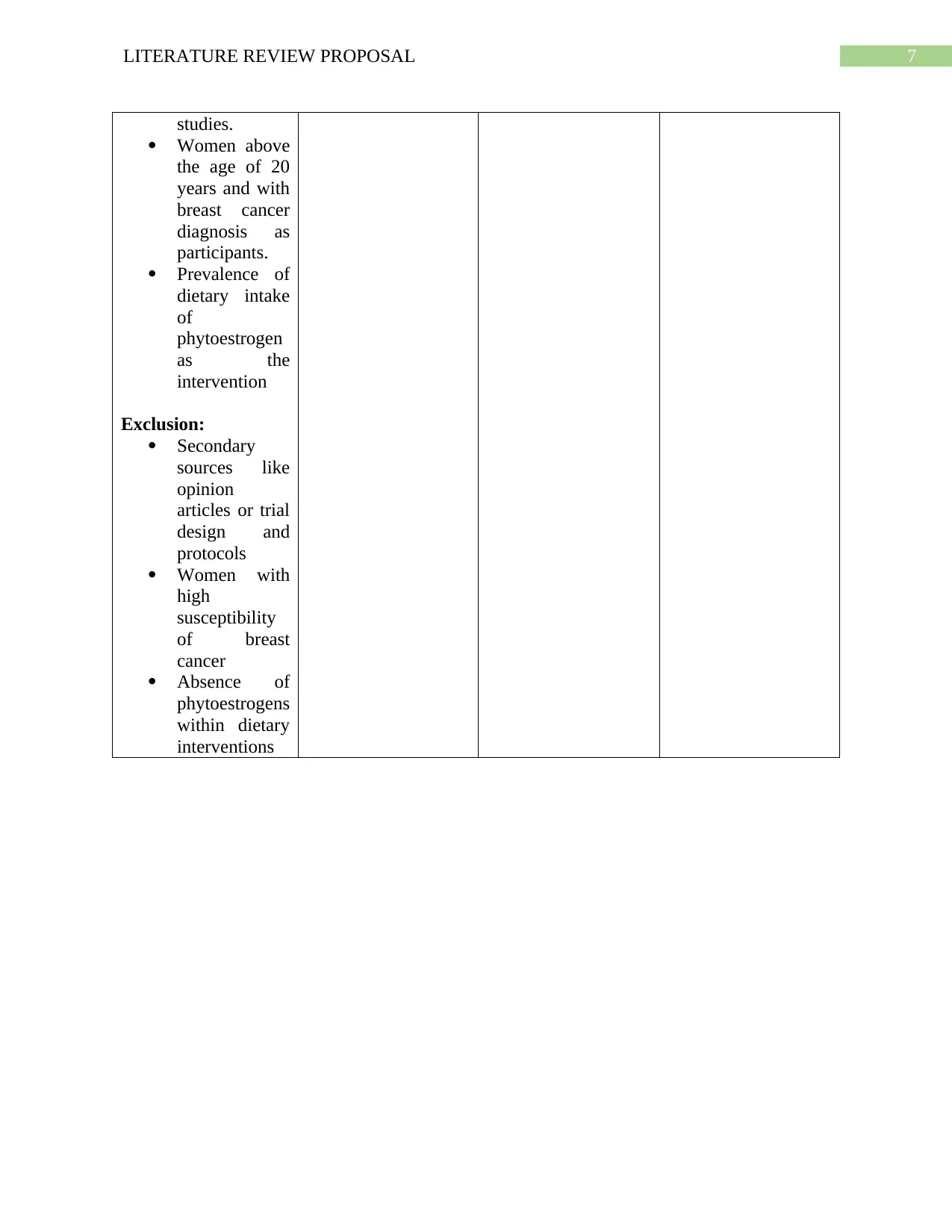
7LITERATURE REVIEW PROPOSAL
studies.
Women above
the age of 20
years and with
breast cancer
diagnosis as
participants.
Prevalence of
dietary intake
of
phytoestrogen
as the
intervention
Exclusion:
Secondary
sources like
opinion
articles or trial
design and
protocols
Women with
high
susceptibility
of breast
cancer
Absence of
phytoestrogens
within dietary
interventions
studies.
Women above
the age of 20
years and with
breast cancer
diagnosis as
participants.
Prevalence of
dietary intake
of
phytoestrogen
as the
intervention
Exclusion:
Secondary
sources like
opinion
articles or trial
design and
protocols
Women with
high
susceptibility
of breast
cancer
Absence of
phytoestrogens
within dietary
interventions
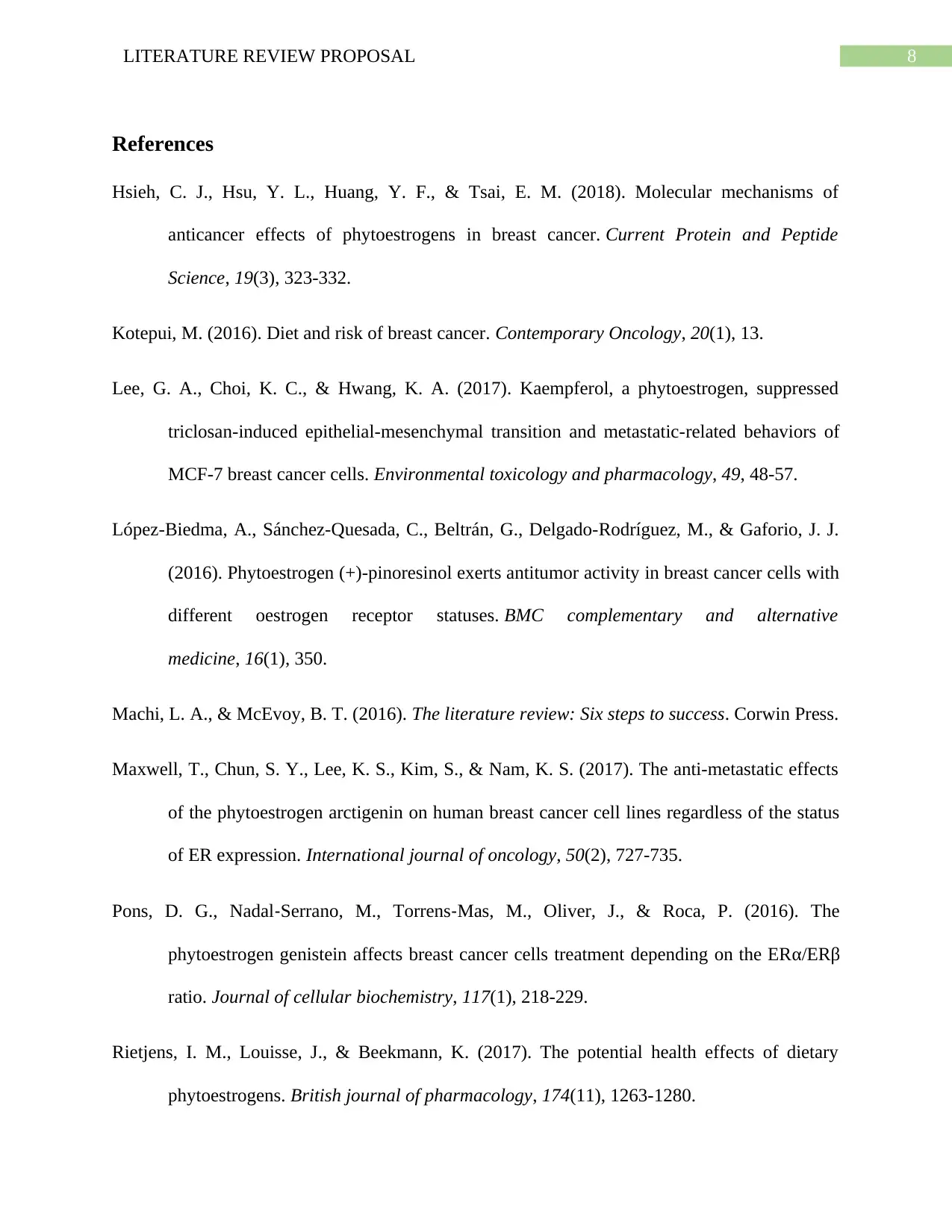
8LITERATURE REVIEW PROPOSAL
References
Hsieh, C. J., Hsu, Y. L., Huang, Y. F., & Tsai, E. M. (2018). Molecular mechanisms of
anticancer effects of phytoestrogens in breast cancer. Current Protein and Peptide
Science, 19(3), 323-332.
Kotepui, M. (2016). Diet and risk of breast cancer. Contemporary Oncology, 20(1), 13.
Lee, G. A., Choi, K. C., & Hwang, K. A. (2017). Kaempferol, a phytoestrogen, suppressed
triclosan-induced epithelial-mesenchymal transition and metastatic-related behaviors of
MCF-7 breast cancer cells. Environmental toxicology and pharmacology, 49, 48-57.
López-Biedma, A., Sánchez-Quesada, C., Beltrán, G., Delgado-Rodríguez, M., & Gaforio, J. J.
(2016). Phytoestrogen (+)-pinoresinol exerts antitumor activity in breast cancer cells with
different oestrogen receptor statuses. BMC complementary and alternative
medicine, 16(1), 350.
Machi, L. A., & McEvoy, B. T. (2016). The literature review: Six steps to success. Corwin Press.
Maxwell, T., Chun, S. Y., Lee, K. S., Kim, S., & Nam, K. S. (2017). The anti-metastatic effects
of the phytoestrogen arctigenin on human breast cancer cell lines regardless of the status
of ER expression. International journal of oncology, 50(2), 727-735.
Pons, D. G., Nadal‐Serrano, M., Torrens‐Mas, M., Oliver, J., & Roca, P. (2016). The
phytoestrogen genistein affects breast cancer cells treatment depending on the ERα/ERβ
ratio. Journal of cellular biochemistry, 117(1), 218-229.
Rietjens, I. M., Louisse, J., & Beekmann, K. (2017). The potential health effects of dietary
phytoestrogens. British journal of pharmacology, 174(11), 1263-1280.
References
Hsieh, C. J., Hsu, Y. L., Huang, Y. F., & Tsai, E. M. (2018). Molecular mechanisms of
anticancer effects of phytoestrogens in breast cancer. Current Protein and Peptide
Science, 19(3), 323-332.
Kotepui, M. (2016). Diet and risk of breast cancer. Contemporary Oncology, 20(1), 13.
Lee, G. A., Choi, K. C., & Hwang, K. A. (2017). Kaempferol, a phytoestrogen, suppressed
triclosan-induced epithelial-mesenchymal transition and metastatic-related behaviors of
MCF-7 breast cancer cells. Environmental toxicology and pharmacology, 49, 48-57.
López-Biedma, A., Sánchez-Quesada, C., Beltrán, G., Delgado-Rodríguez, M., & Gaforio, J. J.
(2016). Phytoestrogen (+)-pinoresinol exerts antitumor activity in breast cancer cells with
different oestrogen receptor statuses. BMC complementary and alternative
medicine, 16(1), 350.
Machi, L. A., & McEvoy, B. T. (2016). The literature review: Six steps to success. Corwin Press.
Maxwell, T., Chun, S. Y., Lee, K. S., Kim, S., & Nam, K. S. (2017). The anti-metastatic effects
of the phytoestrogen arctigenin on human breast cancer cell lines regardless of the status
of ER expression. International journal of oncology, 50(2), 727-735.
Pons, D. G., Nadal‐Serrano, M., Torrens‐Mas, M., Oliver, J., & Roca, P. (2016). The
phytoestrogen genistein affects breast cancer cells treatment depending on the ERα/ERβ
ratio. Journal of cellular biochemistry, 117(1), 218-229.
Rietjens, I. M., Louisse, J., & Beekmann, K. (2017). The potential health effects of dietary
phytoestrogens. British journal of pharmacology, 174(11), 1263-1280.
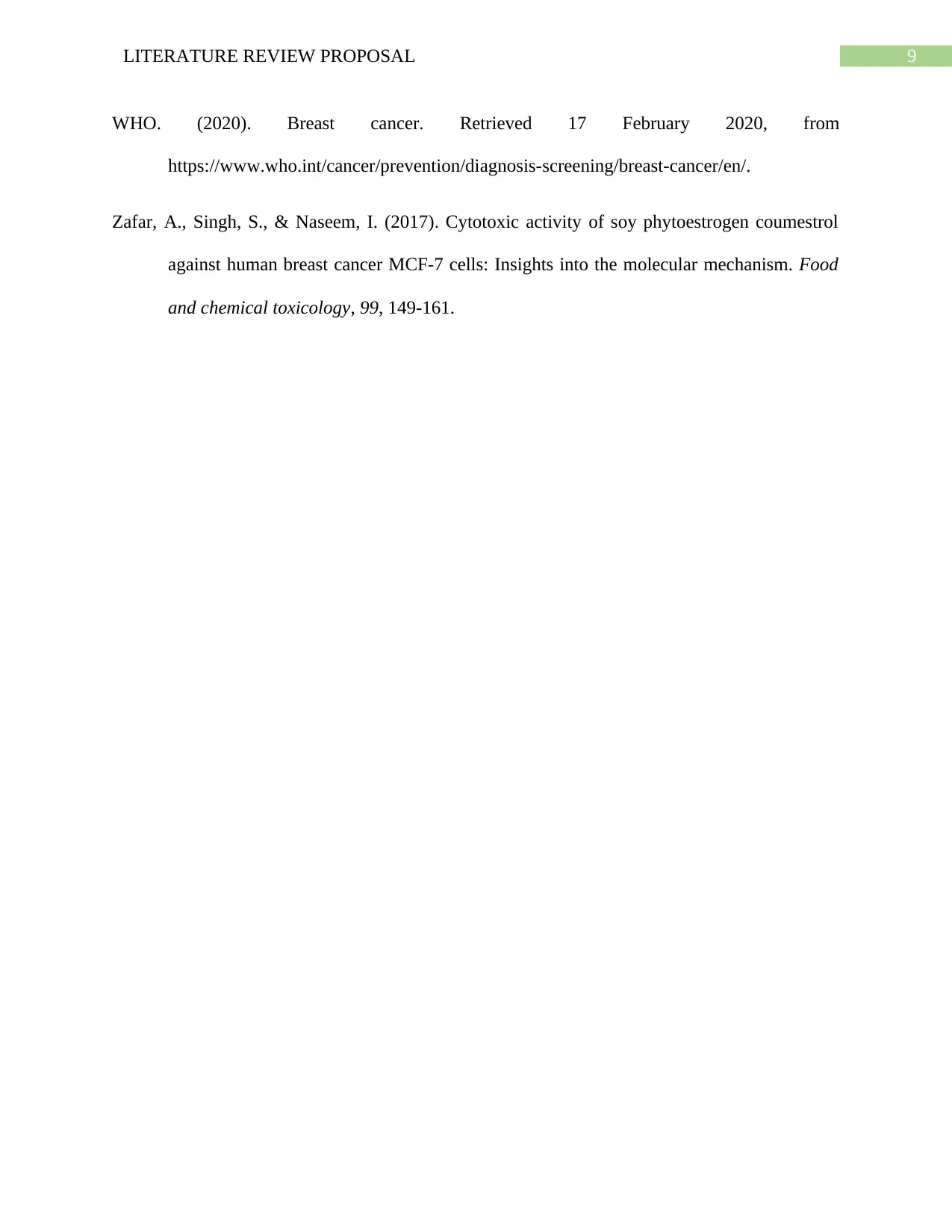
9LITERATURE REVIEW PROPOSAL
WHO. (2020). Breast cancer. Retrieved 17 February 2020, from
https://www.who.int/cancer/prevention/diagnosis-screening/breast-cancer/en/.
Zafar, A., Singh, S., & Naseem, I. (2017). Cytotoxic activity of soy phytoestrogen coumestrol
against human breast cancer MCF-7 cells: Insights into the molecular mechanism. Food
and chemical toxicology, 99, 149-161.
WHO. (2020). Breast cancer. Retrieved 17 February 2020, from
https://www.who.int/cancer/prevention/diagnosis-screening/breast-cancer/en/.
Zafar, A., Singh, S., & Naseem, I. (2017). Cytotoxic activity of soy phytoestrogen coumestrol
against human breast cancer MCF-7 cells: Insights into the molecular mechanism. Food
and chemical toxicology, 99, 149-161.
1 out of 10
Your All-in-One AI-Powered Toolkit for Academic Success.
+13062052269
info@desklib.com
Available 24*7 on WhatsApp / Email
![[object Object]](/_next/static/media/star-bottom.7253800d.svg)
Unlock your academic potential
© 2024 | Zucol Services PVT LTD | All rights reserved.

